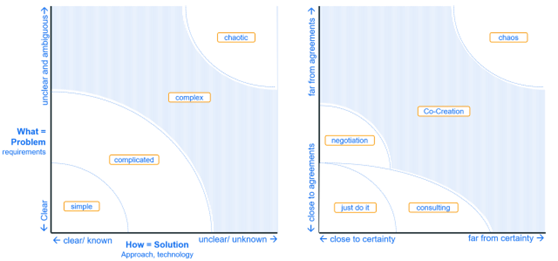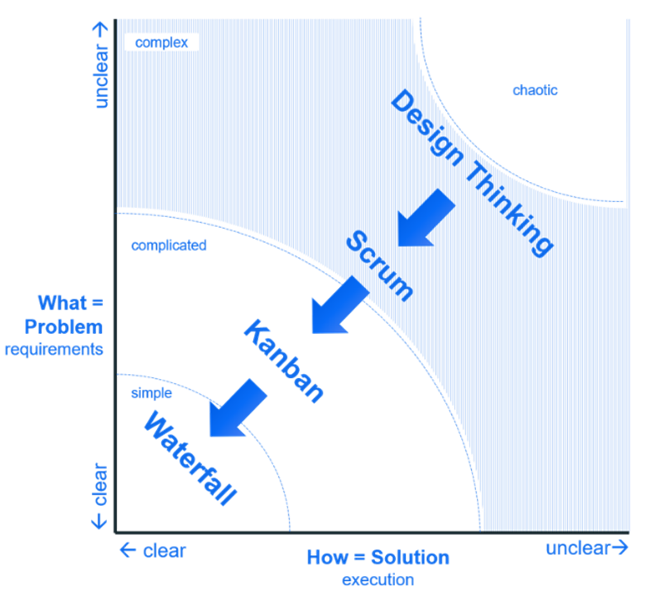The Right Time for Customer Co-Creation: Navigating Complexity

Have you ever wondered why Co-Creation has become such a buzzword in the business world? In the past years, I’ve personally witnessed the rise of Co-Creation alongside the hype of Design Thinking. Initially, I saw various promising approaches where Co-Creation proved to be a valuable tool for companies seeking to develop products and services that genuinely addressed their customers’ needs and desires. However, in recent months, I’ve observed numerous instances where the term ‘Co-Creation’ has been misused and misunderstood. It has become a buzzword in the business world, often used without fully grasping its true essence. While Co-Creation can be a game-changer when implemented correctly, its widespread usage has led to situations where the approach is not always a good idea. If you would like to explore the benefits of Co-Creation and when it’s the right time to apply, this blog post is for you.
What exactly is Co-Creation, and why is it so powerful?
Co-creation refers to a product or service design process in which customers play an active role in shaping the outcome. This can mean gathering feedback, insights, and ideas from customers, or even allowing them to submit designs and content during the product development process. These insights help to develop products that truly meet the customer’s needs. At the same time, it will strengthen the relationship between the company and its customers.
There are various benefits to Co-Creation, including:
- Valuable customer insights and feedback: Co-Creation enables businesses to gain valuable insights and feedback directly from customers, providing a deep understanding of their needs, preferences, and pain points.
- Product relevance meets market fit: Involving customers in the design process ensures that products and services are tailored to their specific needs, leading to higher levels of relevance and better market fit.
- Accelerated innovation: Co-Creation encourages the generation of new ideas and perspectives, fueling innovation within the company. Customers can offer fresh insights and unique solutions that may not have been considered otherwise.
- Competitive advantage: By actively involving customers in the design process, businesses can differentiate themselves from competitors. Co-Creation creates a sense of exclusivity and fosters customer loyalty, giving the company a competitive edge in the market.
- Reduced risk and cost: By gathering customer insights and feedback early in the design process, businesses can minimize the risk of developing products or services that don’t resonate with the market. This helps save time, effort, and resources by avoiding costly product failures.
- Brand advocacy: Co-Creation cultivates a sense of partnership and collaboration between businesses and customers. Engaged customers who contribute to the design process become brand advocates, spreading positive word-of-mouth and attracting new customers to the company.
- Continuous improvement: Co-Creation establishes a feedback loop with customers, enabling ongoing improvement of products and services. Businesses can iterate and refine their offerings based on customer input, ensuring a continuous cycle of enhancement and innovation.
- Market validation: Involving customers in the design process provides real-time validation of product ideas and concepts. Customer feedback and active participation serve as valuable indicators of market demand, reducing the risk of developing products that may not resonate with the target audience.
- Realistic customer expectations and emotional commitment: Involving customers in the design process helps set realistic expectations for their participation, ensuring that their input is valued and respected. This leads to a higher level of emotional commitment and engagement from customers.
Through my own observations, I’ve noticed that internal decisions within companies often rely on assumptions or individual opinions, which can sometimes lead to these decisions being overheard or even ignored by decision makers. On the other hand, it can be risky when these assumptions are taken for granted without being validated by actual customers. However, when the customer’s voice is placed at the center of the design process, internal communication becomes more target-oriented, and decisions become easier to justify. I’ve found that changing the statements from “customers want…” to “customer XY said they want…” makes it much more powerful. It’s easier to dismiss generalized statements but harder to disregard specific customer feedback. By incorporating the voice of the customer, internal decision-making becomes more grounded and less prone to the pitfalls of assumptions and individual opinions.
With Co-Creation, products are developed with customers, not just for them. This results in more concrete customer journeys, precise value propositions, and a stronger case for new products.
When is Co-Creation Right for Your Business?
Co-Creation is frequently misused, with instances where it is employed in situations that do not necessitate its application. I have observed cases where Co-Creation is used inappropriately, either in scenarios where the requirements are already clear and established, or as a buzzword to make a standard service appear more sophisticated or simply to give the customer the impression that they are special. In such cases, the inclusion of ‘Co-Creation’ in the package may create the illusion of added value, even though there may be no pressing problems or desires that require the involvement of your R & D department. This often leads to the initiation of a new project within the R & D department without clear targets, requirements, or timelines, resulting in unrealistic expectations for both your company and the customer, making them impossible to reach.
Co-Creation is particularly useful in complex business environments characterized by uncertainty and ambiguity. When faced with these challenges, traditional approaches may not be enough. In these cases, Co-Creation can help navigate uncertainty, bring different perspectives to the table, and get quick feedback on experiments to gain experience and certainty. Co-Creation might not help in simple and complicated environments. Simple environments benefit more from a just-do-it mentality than adding additional complexity and further stakeholders. Same applies to complicated environments, often consulting or negotiation is needed instead of additional inputs. See the Stacey Matrix below for further illustration.

In a chaotic, volatile, and uncertain environment, Design Thinking can help to bring clarity first by understanding the customers real needs and generating ideas for solutions that fit. Once the goal is clearer the involvement of customers can help those ideas to grow by involving multiple perspectives and experimenting with prototypes. The incremental and iterative process of Scrum can than help to develop products and services while constantly adapting the scope based on collected feedback. When the requirements are clear and there is little uncertainty, other approaches like Kanban or Waterfall might be an option as well, as things get more straightforward and product changes are rarely expected.

How to get started?
Getting started with Co-Creation begins by identifying the right situations where this approach is most beneficial, as discussed earlier. Once you’ve determined that this is the appropriate path, it’s crucial to set it up for success. Selecting the right customer to collaborate with is paramount. An ideal Co-Creation partner is open to collaboration, understanding that initial product iterations may have bugs and requires patience and understanding. The collaboration should be founded on mutual respect, valuing the customer’s time while also recognizing the value they bring. The customer should be willing to share their ideas, pain points, and insights into their daily routines or unsolved needs. It’s essential to emphasize to them that their involvement will help shape the product to meet their specific requirements, allowing them to be the first to benefit from it. Additionally, when selecting the customer, it’s important to ensure they represent a significant percentage of your target market. This ensures that the Co-Created product can be more easily scaled to meet broader market demand, rather than catering solely to one customer’s needs.
In conclusion, Co-Creation, when applied correctly, serves as a powerful tool for companies aiming to develop products that genuinely meet the needs of their customers. By actively involving customers in the design process, businesses can tap into their valuable insights, fuel innovation, and strengthen relationships. The benefits, including gaining valuable customer insights, enhancing customer satisfaction and loyalty, and achieving a competitive advantage, make it an attractive approach. Moreover, in complex and uncertain business environments, Co-Creation proves particularly valuable, enabling businesses to navigate ambiguity and gain invaluable experience and certainty about their product offerings. So, if you find yourself operating in a complex environment and ready to elevate your product design to new heights, I encourage you to embrace Co-Creation as a strategic approach. By leveraging the collective wisdom of your customers, you can unlock a world of possibilities and create products that truly resonate with your target audience.
If you don’t know where or how to start, please don’t hesitate to reach out to us. We are here to guide and support you on your Co-Creation journey, ensuring that you leverage its potential to the fullest.
